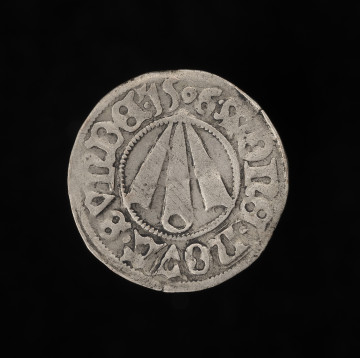
Groschen (Kreuzgroschen)
1613
National Museum in Szczecin
Part of the collection: Pomeranian coins
The fate of Stralsund’s minting in the late Middle Ages was closely tied to the policies of leading Hanseatic cities such as Lübeck and Hamburg, which sought to establish a monopoly on coin production in the Baltic region. As a result, larger monetary units – wittens and schillings – were introduced into circulation, struck according to a unified standard and die design. Around 1365, Lübeck began issuing wittens weighing approximately 1.3 g, featuring the city’s emblem on the obverse and a Greek cross on the reverse. By the turn of the 15th century, these coins had become the dominant currency in the Baltic, widely imitated by major Pomeranian cities. While the imagery was copied, the weight standard was significantly reduced. Early Pomeranian wittens weighed around 1 g, but by the late 14th century, their weight had declined to between 0.9 and 0.7 g. Initially valued at four Lübeck denars, their quality gradually deteriorated, and by the early 15th century, they had been devalued to three denars. Many specimens bear countermarks from major Hanseatic cities, confirming their circulation across a broad trading network. Since wittens lack minting dates, their chronology is based on archaeological context and the dating of finds. Stralsund’s wittens predominantly feature the motifs of an arrow and a cross. Different variants and emissions are distinguished by small additional symbols placed between the arms of the cross or at its centre, such as small arrowheads, crosses, or rosettes. The oldest wittens from Stralsund date to 1367–1368 and are closest in standard to Lübeck’s issues. The specimen on display belongs to the first witten emission from Stralsund and is among the heaviest known examples. The obverse references the city in both its symbol and inscription, while the reverse is entirely religious in nature. Its legend features a biblical quote from Psalm 54:3, similar to the inscriptions found on coins from many Hanseatic cities. Genowefa Horoszko
Author / creator
Object type
coin
Technique
coining
Material
silver
Origin / acquisition method
acquisition
Creation time / dating
Creation / finding place
Owner
The National Museum in Szczecin
Identification number
Location / status

1613
National Museum in Szczecin

1506
National Museum in Szczecin

1429 — 1440
National Museum in Szczecin
DISCOVER this TOPIC
National Museum in Szczecin
DISCOVER this PATH
Educational path